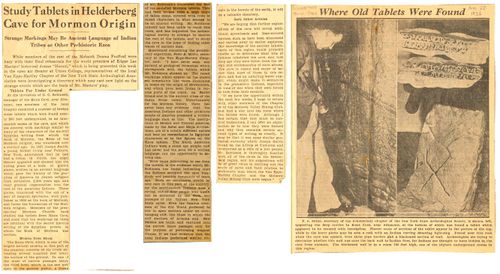Knox Cave Article August 22, 1936
Study Tablets in Helderberg Cave for Mormon Origin
Strange Markings May Be Ancient Language of Indian Tribes or Other Prehistoric Race
While the members of the cast of the Mohawk Drama Festival were busy with their final rehearsals of the world premier of Edgar Lee Masters' historic drama, "Moroni," which is being presented this week in the open air theater at Union College, representatives of the local Van Epps-Hartley Chapter of the New York State Archeological Association were investigating a discovery which may cast new light on the strange events which are the basis of Mr. Masters' play.
Tablet Far Under Ground
At the invitation of D. C. Robinson, manager of the Knox Cave, near Altamont, two members of the local chapter examined a number of broken stone tablets which were found nearly 200 feet underground, in an inaccessible recess of the cave, and which are covered with markings similar to many of the characters of the ancient Egyptian writing from which the Book of Mormon, the Bible of the Mormon religion, was translated over a century ago. In 1827 Joseph Smith, a young farmer living near Palmyra, New York, announced that he had vision in which the angel Moroni appeared and showed him the hiding place of a book of golden plates, written in an ancient language which gave the history of the peopling of America by Jewish refugess from Jerusalem, 2,500 years ago, and their gradual degeneration into the race of American Indians. These plates, translated with the aid of a pair of magical spectacles, were published in 1830 as the Book of Mormon, and forms the foundation of the Mormon religion. Members of the present=day Mormon Church have studied the tablets from Knox Cave, and state that the markings on them are identical with the sacred hieretic writing of the Egyptian priests in which the Book of Mormon was written.
Broken from Block
The Knox Cave, which is one of the largest natural caverns in this part of the country, consists of six levels extending several hundred feet below the surface of the ground. In one of the maze of narrow passages below the third level, which if the one now open to the general public, a friend of Mr. Robinson's discovered the first of the so-called Mormon tablets. They had been broken from a large block of fallen stone, covered with rows of raised characters in what seemed to be an ancient writing. Mr. Robinson himself has been unable to reach this room, and has requested the archaeological society to attempt to recover the rest of the tablets, and the study the cave in the hope of finding other traces of ancient man.
Questioned concerning the preliminary expedition, Peter S. Miller, secretary of the Van Epps-Hartley Chapter, said: "I have never seen any natural of geological formation which corresponds with the tablets which Mr. Robinson showed us. The raised markings which appear on the stones are remarkably like those illustrated in books on the origin of Mormonism, and which have been found in various parts of the world, on Easter Island and in the ancient cities of the Indus River Valley. Unfortunately, for the Mormon theory, there has never been any evidence that the American Indians and other primitive people of America possessed a written language such as this. The inscriptions in Mexico and Central America made by the Aztec and Maya civilizations are of a totally different nature and bear no resemblance to Egyptian characters to the figures on the Knox tablets. The North American Indians were a stone age people, and had never had the need for a written language, nor the opportunity to develop one. \

